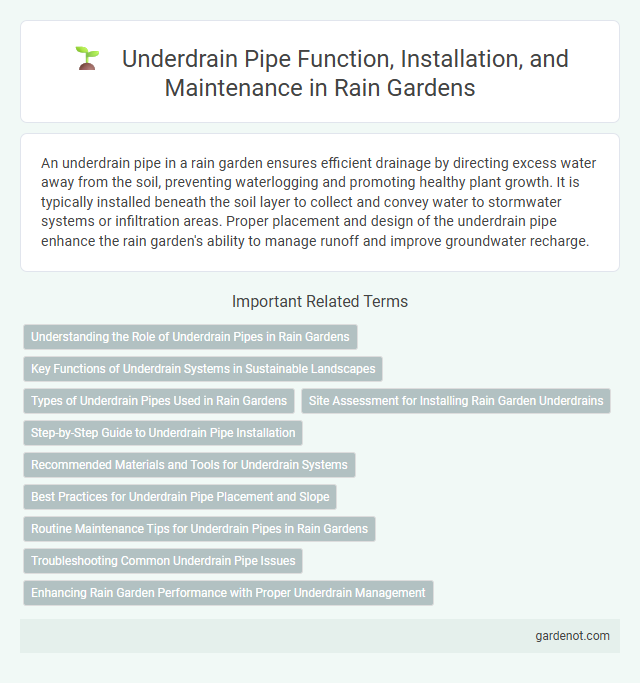An underdrain pipe in a rain garden ensures efficient drainage by directing excess water away from the soil, preventing waterlogging and promoting healthy plant growth. It is typically installed beneath the soil layer to collect and convey water to stormwater systems or infiltration areas. Proper placement and design of the underdrain pipe enhance the rain garden's ability to manage runoff and improve groundwater recharge.
Understanding the Role of Underdrain Pipes in Rain Gardens
Underdrain pipes in rain gardens facilitate efficient water drainage by directing excess runoff away from saturated soil, preventing waterlogging and promoting plant health. These perforated pipes, positioned beneath the soil layer, enhance infiltration rates while maintaining optimal moisture levels for vegetation. Proper installation of underdrain systems ensures effective stormwater management and reduces the risk of standing water and soil erosion.
Key Functions of Underdrain Systems in Sustainable Landscapes
Underdrain pipes in rain gardens play a critical role in managing excess stormwater by facilitating efficient drainage and preventing soil saturation. These systems enhance infiltration rates, reduce surface runoff, and protect plant health by maintaining optimal moisture levels. Effective underdrain systems contribute to groundwater recharge and mitigate flooding risks within sustainable landscape designs.
Types of Underdrain Pipes Used in Rain Gardens
Perforated PVC pipes are the most common type of underdrain pipes used in rain gardens, offering durability and ease of installation while allowing efficient water infiltration. Corrugated HDPE pipes provide flexibility and resistance to corrosion, making them suitable for complex garden layouts and long-term performance. Clay or ceramic pipes, though less common today, are sometimes used for their natural permeability and environmental compatibility in specific rain garden designs.
Site Assessment for Installing Rain Garden Underdrains
Site assessment for installing rain garden underdrains involves evaluating soil permeability, groundwater levels, and slope to ensure proper drainage efficiency. Soil infiltration tests and percolation rates determine if an underdrain pipe is necessary to prevent waterlogging and maintain optimal plant health. Accurate mapping of subterranean utilities and soil composition supports selecting appropriate pipe materials and placement depth for long-term functionality.
Step-by-Step Guide to Underdrain Pipe Installation
To install an underdrain pipe in a rain garden, first excavate a trench at the bottom of the garden bed, ensuring a slight slope for optimal drainage. Next, place a perforated pipe wrapped in a geotextile fabric to prevent soil infiltration, then cover it with clean gravel to facilitate water flow. Finally, backfill soil over the gravel and plant native vegetation to support infiltration and maintain the garden's filtration function.
Recommended Materials and Tools for Underdrain Systems
Recommended materials for underdrain pipes in rain garden systems include perforated PVC or corrugated polyethylene pipes, which provide efficient water conveyance and durability. Essential tools for installation comprise a trenching shovel, a tape measure for precise placement, and a utility knife to cut pipes to the necessary lengths. Incorporating clean gravel bedding around the pipe enhances filtration and reduces clogging, ensuring optimal underdrain performance.
Best Practices for Underdrain Pipe Placement and Slope
Placing underdrain pipes at the lowest point of a rain garden ensures efficient water capture and drainage, preventing waterlogging and promoting healthy plant growth. Maintaining a consistent slope of 1-2% along the pipe length facilitates optimal water flow while minimizing erosion and sediment buildup. Proper underdrain installation improves infiltration rates and extends the rain garden's lifespan by preventing standing water and soil saturation issues.
Routine Maintenance Tips for Underdrain Pipes in Rain Gardens
Regular inspection of underdrain pipes in rain gardens ensures efficient water flow and prevents clogging caused by sediment buildup or root intrusion. Flushing the pipes periodically with clean water removes debris and maintains permeability, while replacing damaged sections promptly reduces the risk of water pooling and infiltration issues. Implementing protective grates or mesh screens at pipe inlets minimizes the entry of large particles, enhancing the longevity and functionality of the drainage system.
Troubleshooting Common Underdrain Pipe Issues
Clogged underdrain pipes in rain gardens often result from sediment buildup or root intrusion, obstructing water flow and reducing system efficiency. Regular inspection and flushing with clean water can prevent blockages, while installing filter fabric around the pipe helps minimize sediment entry. Ensuring proper pipe slope and using corrugated perforated pipes improve drainage and mitigate common underdrain issues effectively.
Enhancing Rain Garden Performance with Proper Underdrain Management
Proper underdrain pipe installation improves rain garden drainage by preventing waterlogging and promoting optimal soil infiltration rates. High-quality perforated pipes ensure efficient subsurface water flow, which minimizes standing water and supports healthy plant growth. Strategic underdrain management enhances pollutant removal, contributing to better stormwater treatment and reducing runoff into nearby waterways.
Underdrain pipe Infographic

 gardenot.com
gardenot.com